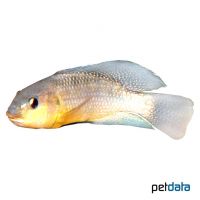Bermin Dwarf Tilapia (Coptodon snyderae)
| Bermin Dwarf Tilapia Coptodon snyderae | |
|---|---|
| Name | Bermin Dwarf Tilapia |
| Name Lat. | Coptodon snyderae |
| Synonym | Tilapia snyderae |
| Family | Cichlids |
| Family lat. | Cichlidae |
| Order | Cichlids |
| Order lat. | Cichliformes |
| Origin | Cameroon, Lake Bermin |
| Habitat | Lake |
| Diet | Omnivore |
| pH | 6.5-7.5 |
| Behavior | Aggressive |
| Keeping | Pair, group |
| Care Level | Moderate |
| Reproduction | Substrate spawner |
| Breeding | Moderately difficult |
| Life Span | 3-5 years |
| Protection | No |
| Metric Units | |
| Size | 6-8 cm |
| Temperature | 22-26 °C |
| Hardness | 5-20 °dH |
| Aquarium | 100 l |
| US Units | |
| Size | 2.4"-3" |
| Temperature | 72-79 °F |
| Hardness | 89-356 ppm |
| Aquarium | 25 gal |
Distribution and habitat
The Bermin Dwarf Tilapia are found exclusively (endemically) in Lake Bermin, a small, shallow crater lake in Cameroon
Maintenance
The aquarium should be equipped with hiding places (crevices and caves) from stones and roots, and have a robust planting. A sandy substrate covered with some foliage (sea almond tree, beech), some subdued light (floating plants) and a slightly acidic water is ideal
No ammonia, ammonium and nitrite should be detectable, the nitrate value should not exceed 100 mg/l. To ensure water quality and oxygen content, a filter and heater adapted to the aquarium size is required, as well as lighting for the species-appropriate day-night rhythm of the animals.
Diet
In nature they feed mainly on algae. The diet consists of a high quality dry food for cichlids (granules, sticks, pellets) with high vegetable content (spirulina, kelp), supplemented with algae leaves or blanched spinach. In addition, they need live or frozen daphnia, artemia, mysis, tubifex and mosquito larvae or a frozen, vitamin-enriched special food mix for cichlids.
Only feed as much as will be eaten within a few minutes. Regular and varied feeding promotes health and increases resistance.
Behaviour and compatibility
They should be kept in pairs or in a group of 6-8 animals. In the group the high intra-species aggression is better distributed. Especially at spawning time they behave extremely aggressive and defend their territory. Keeping a group is only possible in a much larger and richly structured tank. They can be socialized with larger African tetras and cichlids as well as catfishes (e.g. Synodontis, Loricaria)
Basically, only compatible fish species with similar demands on water condition and water temperature should be socialized.
Sex dimorphism
The sexes are difficult to distinguish. The males are slightly larger and more intensely colored than the females.
Reproduction and breeding
They are substrate spawners that practice intensive brood care (parental family). The female spawns in a cave or in a protected place usually 20-40 eggs, rarely up to 100 eggs. After about 8 days the fry swim free and are cared for by the parents for some time before brood care ends
The fry must be fed several times a day with special rearing food (Artemia nauplii). In community tanks breeding is hardly possible, because the fry are easy prey.
Important
They are good algae eaters that do not spurn filamentous algae
There are green, white and red color morphs, although the coloration can also be mood-dependent
The well-being of the fish should be checked regularly. The temperature should be checked daily, the pH, hardness and nitrate value at least every 14 days. Regular partial water changes are recommended, even if the pollutant load has not yet reached the upper limit. Sudden changes in water quality should be avoided. Newly introduced fish must be accustomed slowly to the water in the aquarium.
Further literature can be found in your pet store.
References
Text: petdata; Image: petdata
Source: BMELV (1998): Tierschutzgutachten - Haltung von Zierfischen (Süßwasser); ENGELMANN (2005): Zootierhaltung - Tiere in menschlicher Obhut: Fische, Verlag Harri Deutsch
- Gemäß § 21 Abs. 5 Tierschutzgesetz idgF
